I. What are the General Structural Characteristics of Viruses?
The impact of viruses on public health and disease has always been present. I don’t think we have to look far or think hard for an example, as the COVID-19 pandemic has affected all of us: directly, indirectly, socially, and even personally.
Nevertheless, we’re still fascinated and interested about viruses not just because of their complexity as a biological entity beyond cell theory, but also using the developing studies and research with the hopes of developing therapeutics to benefit the population.
Viruses are quite fascinating as even though they aren’t regarded as living organisms, their structure and life cycle surely do have the complexities of one. Luckily, being much smaller subcellular entities, their structure is much simpler than cells!
II. Foundations of Viral Structure
As mentioned above, because of their subcellular nature, viruses have much simpler, though still complex, structures. Let’s take a look at some of their common components!
A. Viral Structural Components
Typically, viruses will have 2 main components: a capsid protein shell and nucleic acid genome. When the capsid shell encloses the genome, it’s referred to as the nucleocapsid.
Sometimes, the virus can be further enclosed by a lipid membrane, termed enveloped for its presence and nonenveloped for a lack of one.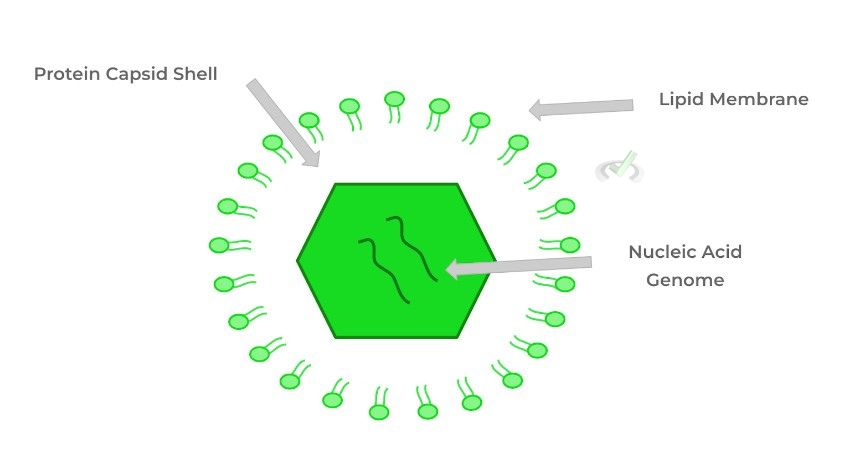
This membrane is often acquired when the virus “buds” off from the cell membrane, an important part of an enveloped virus’ life cycle!
Because of this, some of the viral proteins will be inserted into the membrane and will become part of the viral particle upon membrane budding!I. Genomic Content: DNA v.s. RNA
Recall that viruses break the 4th tenet of cell theory as they have the capability to have both DNA and RNA genomes that can be either single or double stranded!
Single stranded RNA genomes can either be positive (+) or negative (-) sense RNA, describing if they’re able to undergo translation immediately.
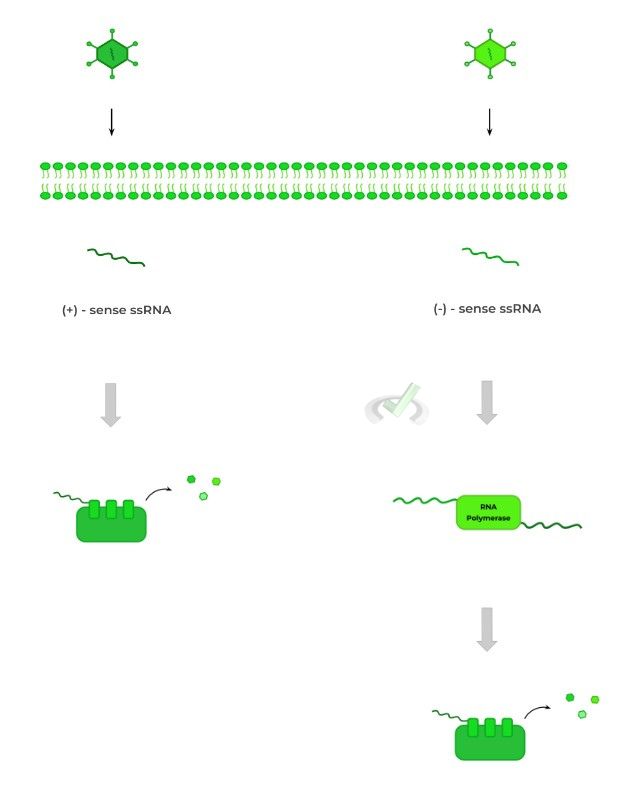
(+)-sense ssRNA genomes can immediately undergo translation and produce the viral proteins. (-)-sense ssRNA must first be transcribed into its complementary (+)-sense sequence before undergoing translation!
II. Lack of Nucleus and Organelles
Another crucial concept about viral structure is their lack of nucleus and membrane bound organelles as seen in eukaryotes.
This also includes ribosomes which is why viruses need to infect cells, as they utilize the cellular machinery for their own reproduction.
However, some viruses do contain polymerase enzymes also enclosed within the viral capsid for certain viruses! Let’s look at a couple examples!

Retroviruses must include a reverse transcriptase enzyme in order to generate cDNA from its RNA genome.
Likewise, an RNA-dependent-RNA-polymerase (RDRP) is included in all (-)-sense ssRNA viruses in order to generate its complementary (+)-sense RNA
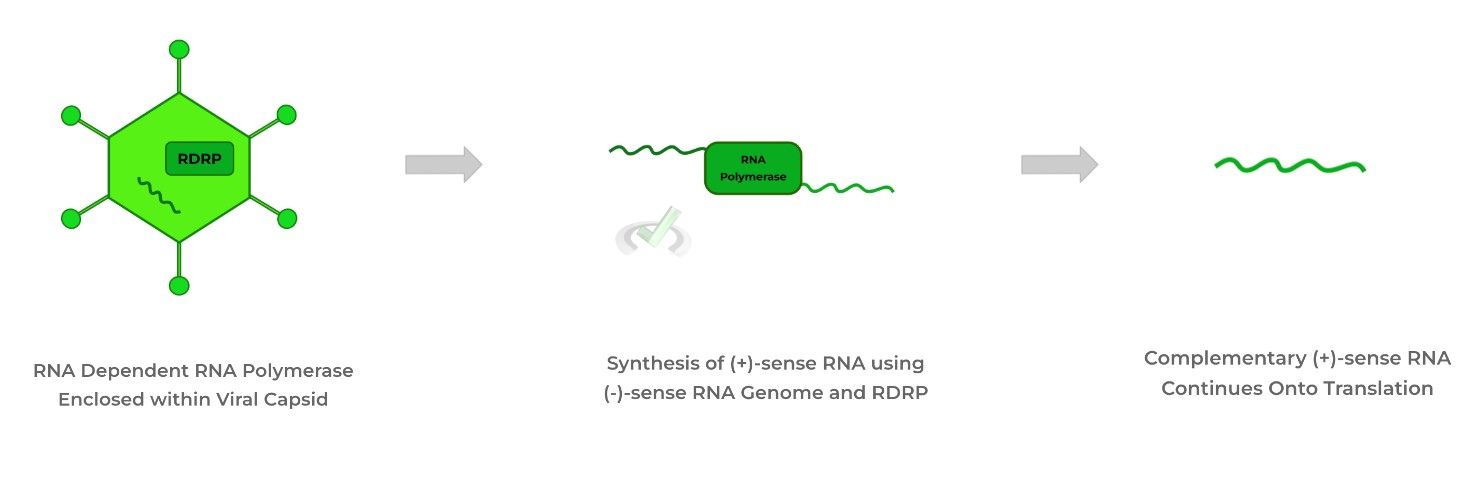
III. Relative Size to Prokaryotic and Eukaryotic Cells
As you’ve probably already noticed, viruses are really small! Even the largest viruses only are about 500 nm in diameter with some of the smallest viruses reaching only about 20 nm!
When compared to prokaryotes and eukaryotes, viruses are 10 and 100 times smaller respectively!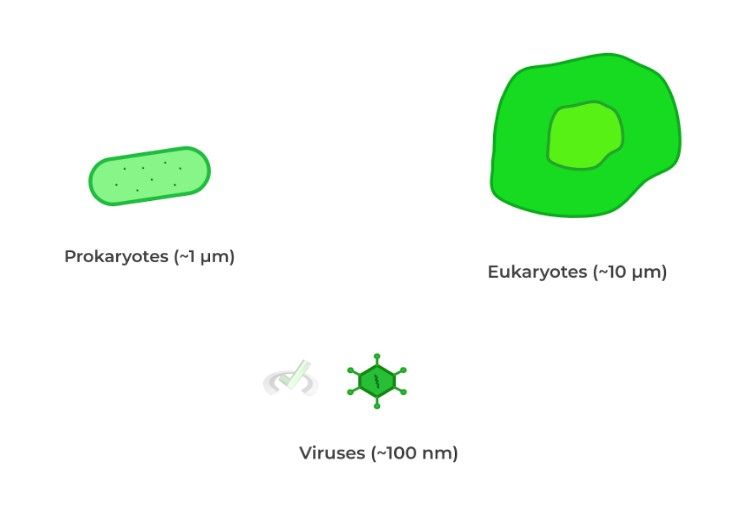
This only contributes to their efficiency and complexity as a subcellular parasite. Because they’re small, the viral genome only codes for the necessary proteins needed for viral infection.
In addition, their hijacking of cell machinery comes from their lack of their own machinery due to their small size.B. Case Study: Structural Aspects of Bacteriophages
You won’t be required to memorize any virus for the MCAT, but one good one to be familiar with is a bacteriophage: a virus which specifically infects bacteria.
While having all the necessary viral structural components, they also have some other unique components.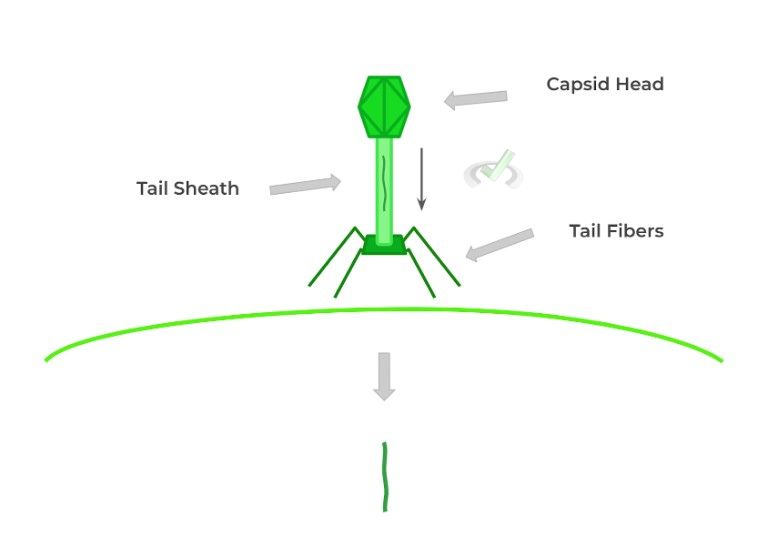
In addition to the viral genome enclosed in the capsid head, bacteriophages also have a tail sheath and tail fibers.
The tail fibers kinda act as “latches” and secure the bacteriophage onto the bacteria. Once secured, the tail sheath functions similar to a syringe and “injects” the viral genome into the bacteria, initiating viral infection.
III. Bridge/Overlap
Why do only some viruses need to have a polymerase enclosed? Why don’t all viruses have a polymerase within their capsid? The answer comes down to whether they’re absolutely necessary. Let’s look at an example!
I. Polymerase Inclusion or Exclusion from Viral Particle
A big part of whether a virus will need to include a polymerase depends on whether the polymerase is available within the cell. If it is, the virus will most likely NOT include the polymerase and will utilize the polymerase available with the cell.
This is the case for most DNA viruses as the replication and transcription machinery is already present within the cell to be used for viral infection.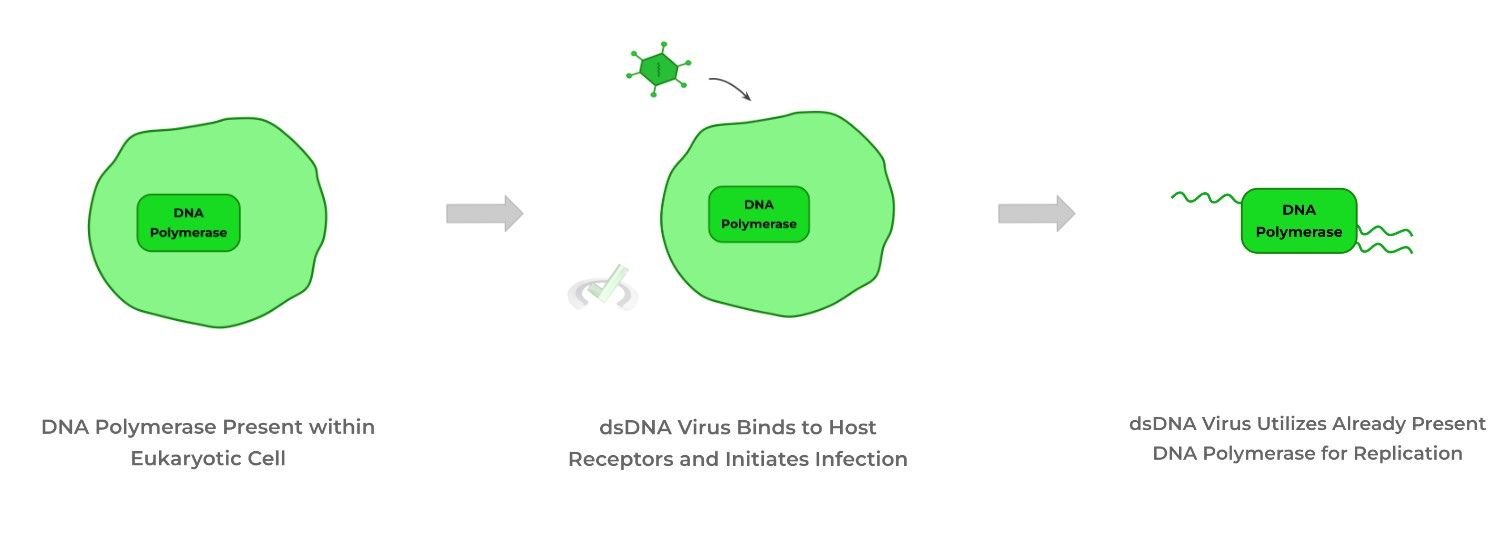
In the case for retroviruses, a reverse transcriptase must be included within the viral particle because cells don’t have this enzyme as there’s no need for it.
Specifically, reverse transcriptase is called an RNA-dependent-DNA-polymerase as it “depends” on a RNA template to produce the cDNA.
IV. Wrap Up/Key Terms
Let’s take this time to wrap up & concisely summarize what we covered above in the article!
A. Viral Structural Components
All viruses have 2 main components: a capsid protein shell and nucleic acid genome, which are known as the nucleocapsid when the capsid encloses the genome.
Viruses can also be enveloped or nonenveloped, referring to the presence of a lipid membrane enclosing the virus. Note that not all viruses are enveloped!I. Genomic Content: DNA v.s. RNA
Because viruses can have either DNA or RNA, single or double stranded, as their genome, they break the 4th tenet of cell theory.
Single stranded RNA genomes can either be (+) or (-) sense. If the RNA genome can be translated immediately, it is a (+)-sense genome.
A (-)-sense genome must first utilize an RNA dependent RNA polymerase to transcribe a complementary (+)-sense strand which can undergo translation.II. Lack of Nucleus and Organelles
A key characteristic of viruses is their simplicity, shown by their lack of nucleus and organelles which is why they utilize cell machinery for their own reproduction.
However, some viruses do contain polymerase enzymes for certain viruses! For example, retroviruses contain reverse transcriptase to generate cDNA.III. Relative Size to Prokaryotic and Eukaryotic Cells
Viruses are so small that when compared to prokaryotes and eukaryotes, which are already smalle, they are 10 and 100 times smaller respectively!
B. Case Study: Structural Aspects of Bacteriophages
Bacteriophages are a group of viruses that specifically target and infect bacterial cells. While having the fundamental viral structural components, they also have tail sheath and tail fiber structures.
The tail fibers acts as a “latch”, anchoring the phage to the bacteria while the tail sheath acts similar to a syringe and “injects” the viral genome into the bacterium, initiating infection.V. Practice
Take a look at these practice questions to see and solidify your understanding!
Sample Practice Question 1:
Which of the following is NOT always present with a virus?
I. DNA or RNA Genome
II. Polymerase Enzymes
III. Lipid Membrane
IV. Protein Capsid Shell
A. II only
B. IV only
C. I and IV
D. II and III
Ans. D
It may be better to approach this question by asking what is always present in viral structure, which in this case is the nucleic acid genome and protein capsid shell.
However, only some viruses will have polymerase enzymes included within the viral particle. Likewise, only some viruses will have a lipid membrane, termed “enveloped”.
Sample Practice Question 2:
A virus infects a cell that has a cell wall, but no other membrane bound organelles. What is the best classification of this virus?
A. Bacteriophage, because it infects a eukaryotic cell
B. Bacteriophage, because it infects a bacterial cell
C. Eukaryotic Virus, because it infects a eukaryotic cell
D. Eukaryotic Virus, because it infects a bacterial cell
Ans. B
Recall that bacterial cells are prokaryotic cells which are defined by their lack of membrane bound organelles and a true nucleus, replaced by a DNA circular chromosome located in the nucleoid region.
Likewise, bacteriophages specifically target bacterial cells, as hinted by the description of the cell in the question stem.







 To help you achieve your goal MCAT score, we take turns hosting these
To help you achieve your goal MCAT score, we take turns hosting these 





















 reviews on TrustPilot
reviews on TrustPilot